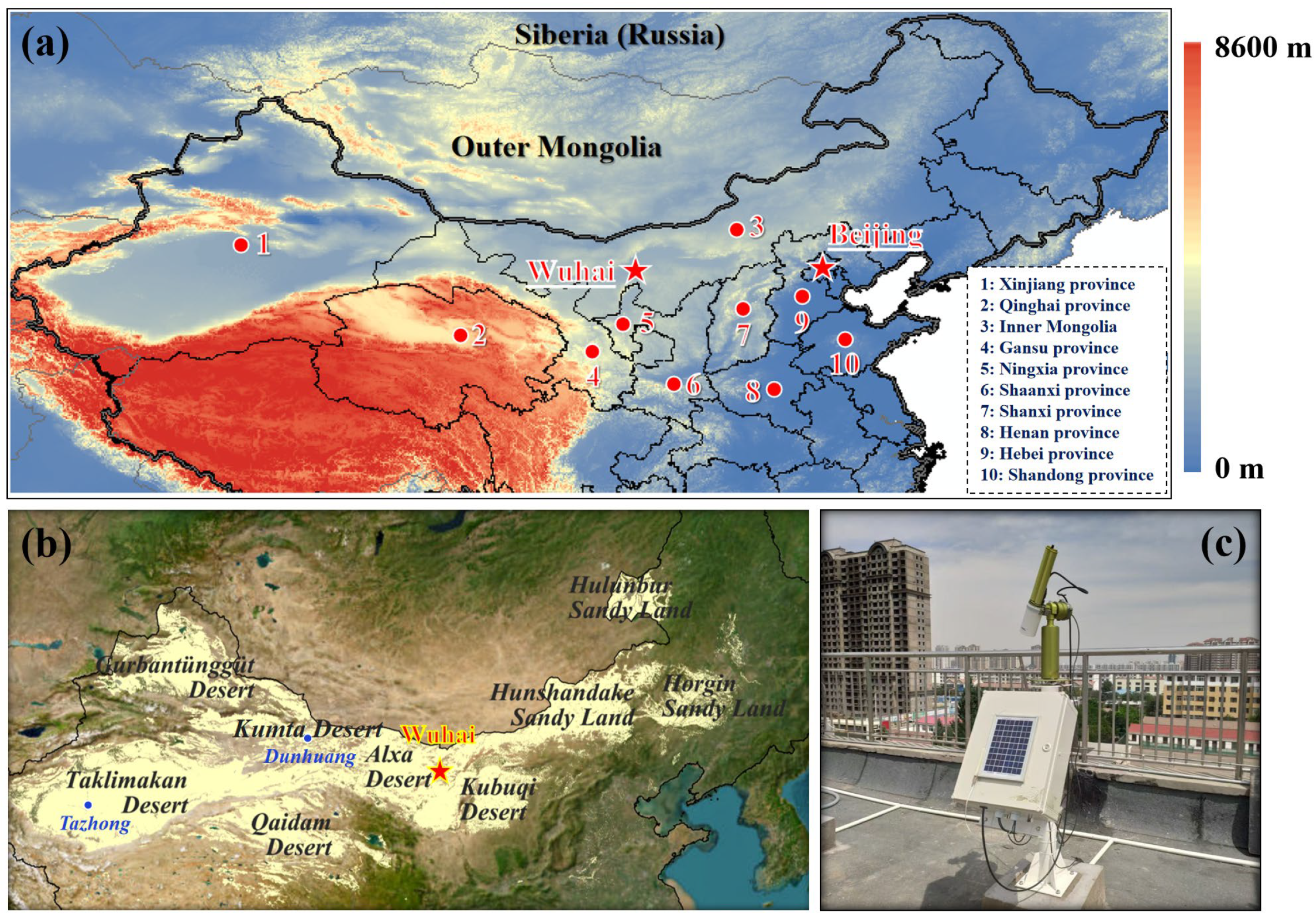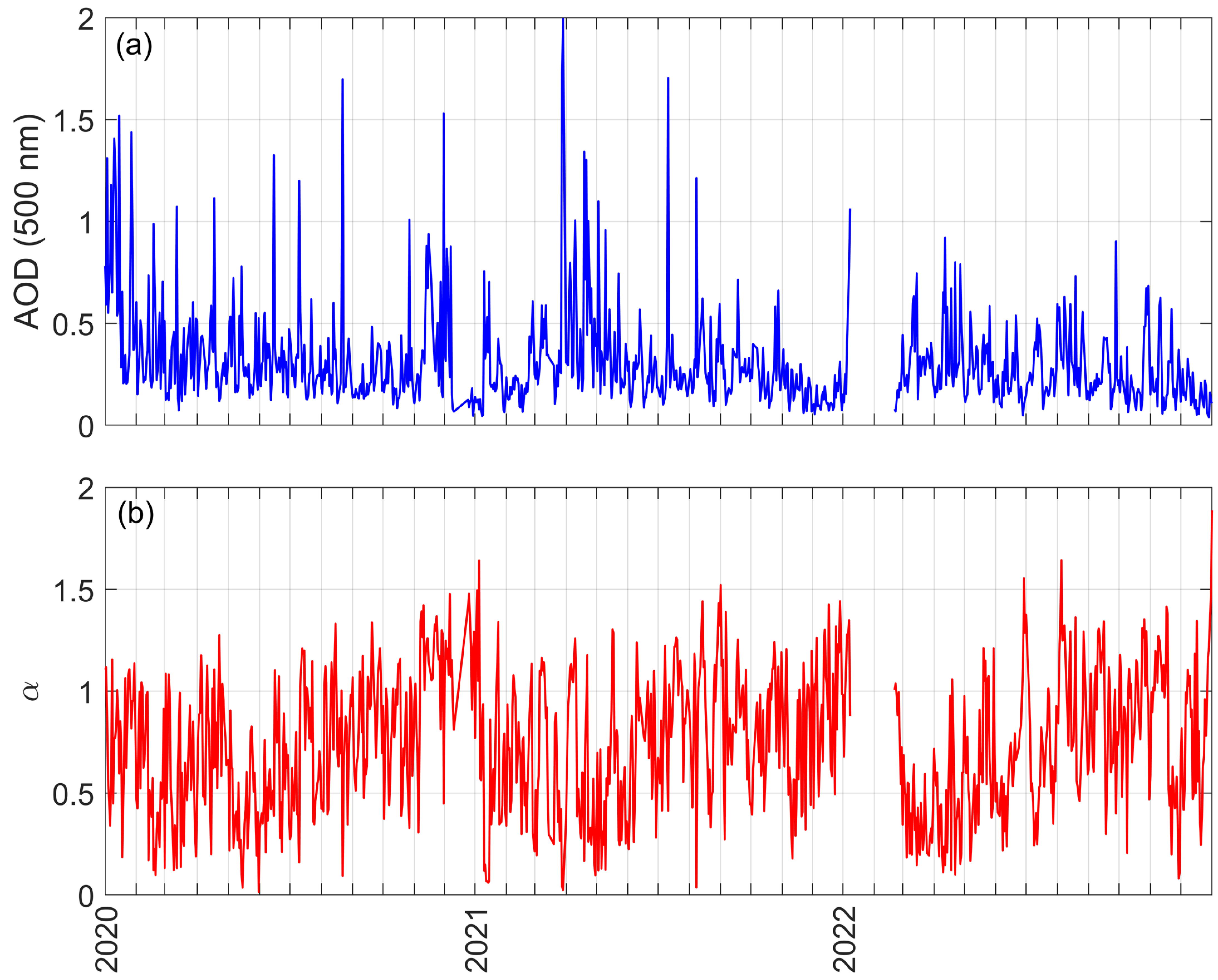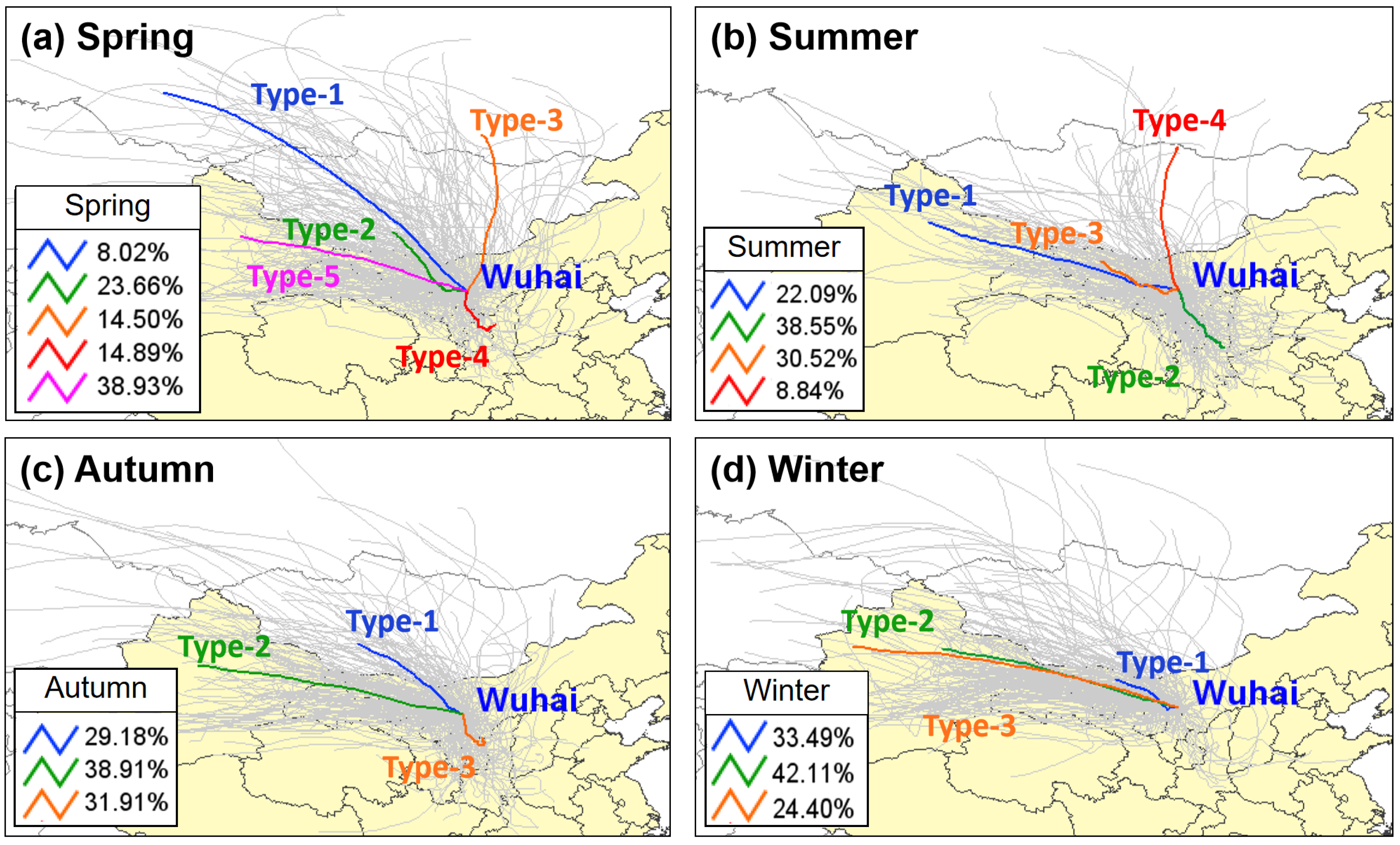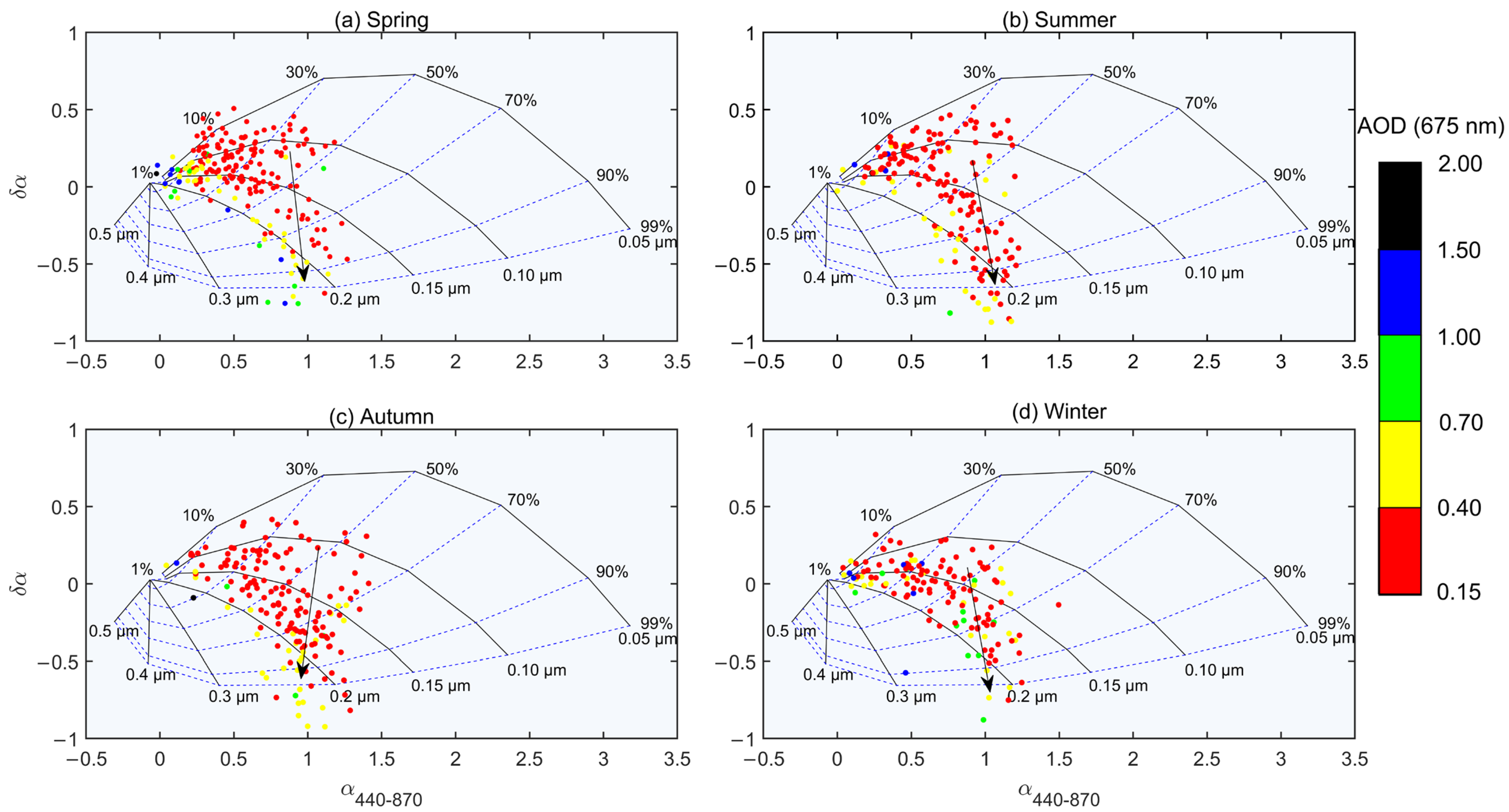The Aerosol Optical Properties over a Desert Industrial City Wuhai, Northwest China, During the 3-Year COVID-19 Pandemic
Abstract
1. Introduction
2. Methodology
2.1. Wuhai Super Site
2.2. Sun-Sky-Lunar CIMEL CE318-T Multiband Photometer
2.2.1. Aerosol Optical Depth
- ①
- Daytime AOD
- ②
- Nighttime AOD
2.2.2. Ångström Exponent α
2.3. TrajStat for Backward Trajectory Analysis
2.3.1. Backward Trajectory Cluster
2.3.2. Potential Source Contribution Function
3. Results
3.1. General Characteristics of the Aerosol Optical Properties in Wuhai
3.2. PSCF Analysis for Source Apportionment
3.3. Aerosol Optical Properties in Different Backward Trajectory Clusters
3.4. Influences of Different Typs of Aerosols
3.4.1. Aerosol Classification Diagram
3.4.2. Bird-Wing Diagram
4. Conclusions
- (1)
- The aerosol optical properties during 2020–2022 indicate a slightly polluted level of a mixture of coarse-mode dust aerosols and fine-mode anthropogenic aerosols. The seasonal highest AOD primarily appears in spring because of the frequent dust events, while the lowest mainly occurs in winter.
- (2)
- Source apportionments identified the Alxa Desert as a major potential source throughout the year, and anthropogenic industrial and mining activities in northern Ningxia and southern Inner Mongolia were also important contributors during spring, summer, and autumn. Particularly in summer, the zones of influence cover most of the central parts of north China, including much of Shaanxi, central and southern Shanxi, western Henan, and even the western border of Hebei province.
- (3)
- The northwest (NW-quadrant) wind originating from the depopulated-zone desert or Gobi area dominates Wuhai, and the remaining parts come from the southeastern (SE-quadrant) areas of densely populated areas. Despite the dominance of NW air flows, SE anthropogenic air masses contribute to the highest aerosol loading and finest particle sizes. Therefore, it can be concluded that anthropogenic influence remains significant over this areas even under strict control measures during the COVID-19 lockdown.
- (4)
- The clarifications show that in the southeast air flows, aerosols are predominantly of anthropogenic origin and consist of a mixture of coarse- and fine-mode aerosols, while for the northwest air flows, coarse-mode dust dominates. Moreover, it is also found that the particles leading to moderate pollution primarily range around 0.2–0.25 µm, and fine particle pollution persists all the year round.
Author Contributions
Funding
Institutional Review Board Statement
Informed Consent Statement
Data Availability Statement
Conflicts of Interest
References
- IPCC. Climate Change 2013: The Physical Science Basis; Contribution of Working Group I to the Fifth Assessment Report of the Intergovernmental Panel on Climate Change; Cambridge University Press: Cambridge, UK; New York, NY, USA, 2013. [Google Scholar]
- Dubovik, O.; Smirnov, A.; Holben, B.N.; King, M.D.; Kaufman, Y.J.; Eck, T.F. Accuracy assessments of aerosol optical properties retrieved from Aerosol Robotic Network (AERONET) Sun and sky radiance measurements. J. Geophys. Res. 2000, 105, 9791–9806. [Google Scholar] [CrossRef]
- Li, J.; Carlson, B.E.; Yung, Y.L.; Lv, D.R.; Hansen, J.; Penner, J.E.; Liao, H.; Ramaswamy, V.; Kahn, R.A.; Zhang, P.; et al. Scattering and absorbing aerosols in the climate system. Nat. Rev. Earth Env. 2022, 3, 363–379. [Google Scholar] [CrossRef]
- Ma, Y.J.; Ye, J.H.; Xin, J.Y.; Zhang, W.Y.; Vilà-Guerau de Arellano, J.; Wang, S.G.; Zhao, D.D.; Dai, L.D.; Ma, Y.X.; Wu, X.Y.; et al. The Stove, Dome, and Umbrella Effects of Atmospheric Aerosol on the Development of the Planetary Boundary Layer in Hazy Regions. Geophy. Res. Lett. 2020, 47, e2020GL087373. [Google Scholar] [CrossRef]
- Xin, J.Y.; Wang, Y.S.; Pan, Y.P.; Ji, D.S.; Liu, Z.R.; Wen, T.X.; Wang, Y.H.; Li, X.R.; Sun, Y.; Sun, J.; et al. The campaign on atmospheric aerosol research network of china: Care-China. Bull. Am. Meteorol. Soc. 2015, 96, 1137–1155. [Google Scholar] [CrossRef]
- Li, Z.Q.; Lau, W.K.-M.; Ramanathan, V.; Wu, G.; Ding, Y.; Manoj, M.G.; Liu, J.; Qian, Y.; Li, J.; Zhou, T.; et al. Aerosol and monsoon climate interactions over Asia. Rev. Geophys. 2016, 54, 866–929. [Google Scholar] [CrossRef]
- Xin, J.Y.; Wang, Y.S.; Li, Z.Q.; Wang, P.C.; Hao, W.M.; Nordgren, B.; Wang, S.; Liu, G.; Wang, L.; Wen, T.; et al. Aerosol optical depth (AOD) and Ångström exponent of aerosols observed by the Chinese sun Hazemeter network from August 2004 to September 2005. J. Geophys. Res. 2007, 112, D05203. [Google Scholar] [CrossRef]
- Che, H.Z.; Zhang, X.Y.; Xia, X.A.; Goloub, P.; Holben, B.; Zhao, H.J.; Wang, Y.; Zhang, X.C.; Wang, H.; Blarel, L.; et al. Ground-based aerosol climatology of China: Aerosol optical depths from the china aerosol remote sensing network (CARSNET) 2002–2013. Atmos. Chem. Phys. 2015, 15, 7619–7652. [Google Scholar] [CrossRef]
- Kong, L.B.; Xin, J.Y.; Zhang, W.Y.; Wang, Y.S. The empirical correlations between PM2.5, PM10 and AOD in the Beijing metropolitan region and the PM2.5, PM10 distributions retrieved by MODIS. Environ. Pollut. 2016, 216, 350–360. [Google Scholar] [CrossRef]
- Gui, K.; Che, H.Z.; Wang, Y.Q.; Xia, X.A.; Holben, B.N.; Goloub, P.; Cuevas-Agulló, E.; Yao, W.R.; Zheng, Y.; Zhao, H.J.; et al. A global-scale analysis of the MISR Level-3 aerosol optical depth (AOD) product: Comparison with multi-platform AOD data sources. Atmos. Pollut. Res. 2021, 12, 101238. [Google Scholar] [CrossRef]
- Li, H.; He, X.Q.; Shanmugam, P.; Bai, Y.; Wang, D.F.; Li, T.; Gong, F. Assessing and Improving the Accuracy of Visible Infrared Imaging Radiometer Suite Ocean Color Products in Environments with High Solar Zenith Angles. Remote Sens. 2024, 16, 339. [Google Scholar] [CrossRef]
- Tian, P.F.; Cao, X.J.; Zhang, L.; Sun, N.X.; Sun, L.; Logan, T.; Shi, J.S.; Wang, Y.; Ji, Y.M.; Lin, Y.; et al. Aerosol vertical distribution and optical properties over China from long-term satellite and ground-based remote sensing. Atmos. Chem. Phys. 2017, 17, 2509–2523. [Google Scholar]
- Zhang, W.H.; Gu, X.F.; Xu, H.; Yu, T.; Zheng, F.J. Assessment of OMI near-UV aerosol optical depth over Central and East Asia. J. Geophys. Res. Atmos. 2015, 121, 382–398. [Google Scholar]
- Zhao, M.; Dai, T.; Goto, D.; Wang, H.; Shi, G.Y. Assessing the assimilation of Himawari-8 observations on aerosol forecasts and radiative effects during pollution transport from South Asia to the Tibetan Plateau. Atmos. Chem. Phys. 2024, 24, 235–258. [Google Scholar]
- Holben, B.N.; Eck, T.F.; Slutsker, I.; Tanre, D.; Buis, J.P.; Setzer, A.; Vermote, I.E.; Reagan, J.A.; Kaufman, Y.J.; Nakajima, T.; et al. AERONET-A federated instrument network and data archive for aerosol characterization. Remote Sens. Environ. 1998, 66, 1–16. [Google Scholar]
- Bokoye, A.I.; Royer, A.; O’Neill, N.T.; Fedosejevs, G.; Teillet, P.M.; McArthur, L.J.B. Characterization of atmospheric aerosols across Canada from a ground-based Sunphotometer network: AEROCAN. Atmos. Ocean 2001, 39, 429–456. [Google Scholar]
- Goloub, P.; Li, Z.Q.; Dubovik, O.; Blarel, L.; Podvin, T.; Jankowiak, I.; Lecoq, R.; Deroo, C.; Chatenet, B.; Morel, J.P.; et al. PHOTONS/AERONET sun photometer network overview: Description, activities, results. Fourteenth Int. Symp. Atmos. Ocean. Opt. Atmos. Phys. 2008, 6936, 218–232. [Google Scholar]
- Yu, J.; Che, H.Z.; Chen, Q.L.; Xia, X.A.; Zhao, H.J.; Wang, H.; Wang, Y.Q.; Zhang, X.Y.; Shi, G.Y. Investigation of Aerosol Optical Depth (AOD) and Angstrom Exponent over the Desert Region of Northwestern China Based on Measurements from the China Aerosol Remote Sensing Network(CARSNET). Aerosol Air Qual. Res. 2015, 15, 2024–2036. [Google Scholar]
- Zong, X.M.; Xia, X.A.; Che, H.Z. Validation of aerosol optical depth and climatology of aerosol vertical distribution in the Taklimakan Desert. Atmos. Pollut. Res. 2015, 6, 239–244. [Google Scholar] [CrossRef]
- Li, J.L.; Ge, X.Y.; He, Q.; Abbas, A. Aerosol optical depth (AOD): Spatial and temporal variations and association with meteorological covariates in Taklimakan desert, China. Peer J. 2021, 9, e10542. [Google Scholar]
- Xia, X.A.; Chen, H.B.; Wang, P.C. Aerosol properties in a Chinese semiarid region. Atmos. Environ. 2004, 38, 4571–4581. [Google Scholar]
- Ma, Y.J.; Xin, J.Y.; Ma, Y.N.; Kong, L.B.; Zhang, K.Q.; Zhang, W.Y.; Wang, Y.S.; Wang, X.Q.; Zhu, Y.F. Optical properties and source analysis of aerosols over a desert area in Dunhuang, Northwest China. Adv. Atmos. Sci. 2017, 34, 1017–1026. [Google Scholar]
- Gong, C.S.; Xin, J.Y.; Wang, Y.; Zhao, C.L.; Yan, P.C.; Wen, T.X.; Song, T.; Yang, Z. The contribution of aerosols chemical components to aerosol optical depth: The method and the case in Dunhuang. Atmos. Res. 2021, 258, 105652. [Google Scholar] [CrossRef]
- Mao, J.D.; Sheng, H.J.; Zhao, H.; Zhou, C.Y. Observation Study on the Size Distribution of Sand Dust Aerosol Particles over Yinchuan, China. Adv. Meteorol. 2014, 1, 157645. [Google Scholar] [CrossRef]
- Xin, J.Y.; Wang, S.G.; Wang, Y.S.; Yuan, J.Y.; Zhang, W.Y.; Sun, Y. Optical properties and size distribution of dust aerosols over the Tengger Desert in Northern China. Atmos. Environ. 2005, 39, 5971–5978. [Google Scholar] [CrossRef]
- Wong, W.M.; Wang, X.; Wang, Y.F. The intersection of COVID-19 and air pollution: A systematic literature network analysis and roadmap for future research. Environ. Res. 2023, 237, 116839. [Google Scholar] [CrossRef]
- Wu, X.; Nethery, R.C.; Sabath, M.B.; Braun, D.; Dominici, D. Air pollution and COVID-19 mortality in the United States: Strengths and limitations of an ecological regression analysis. Sci. Adv. 2020, 6, eabd4049. [Google Scholar]
- Le, T.H.; Wang, Y.; Liu, L.; Yang, J.N.; Yung, Y.L.; Li, G.H.; Seinfeld, J.H. Unexpected air pollution with marked emission reductions during the COVID-19 outbreak in China. Science 2020, 369, 702–706. [Google Scholar] [CrossRef]
- Zhang, X.H.; Tang, M.L.; Guo, F.J.; Wei, F.; Yu, Z.B.; Gao, K.; Jin, M.J.; Wang, J.B.; Chen, K. Associations between air pollution and COVID-19 epidemic during quarantine period in China. Environ. Pollut. 2021, 268, 115897. [Google Scholar] [CrossRef]
- Zeng, W.X.; Chen, X.; Tang, K.F.; Qin, Y.F. Does COVID-19 lockdown matter for air pollution in the short and long run in China? A machine learning approach to policy evaluation. J. Environ. Manage. 2024, 370, 122615. [Google Scholar] [CrossRef]
- Barreto, Á.; Cuevas, E.; Granados-Muñoz, M.-J.; Alados-Arboledas, L.; Romero, P.M.; Gröbner, J.; Kouremeti, N.; Almansa, A.F.; Stone, T.; Toledano, C. The new sun-sky-lunar Cimel CE318-T multiband photometer—A comprehensive performance evaluation. Atmos. Meas. Tech. 2016, 9, 631–654. [Google Scholar] [CrossRef]
- Kasten, F. A new table and approximate formula for relative optical air mass. Arch. Meteorol. Geophys. Bioclimatol. 1966, 14, 206–233. [Google Scholar] [CrossRef]
- Kasten, F.; Young, A.T. Revised optical air mass tables and approximation formula. Appl. Opt. 1989, 28, 4735–4738. [Google Scholar] [CrossRef] [PubMed]
- Komhyr, W.D.; Mateer, C.L.; Hudson, R.D. Operations Handbook—Ozone Observations with a Dobson Spectrophotometer; WMO Global Ozone Research and Monitoring Project 1980, Report No.6; WMO: New York, NY, USA, 1980. [Google Scholar]
- Li, Z.; Blarel, L.; Podvin, T.; Goloub, P.; Buis, J.P.; Morel, J.P. Transferring the calibration of direct solar irradiance to diffuse sky radiance measurements for Cimel sun-sky radiometers. Appl. Opt. 2008, 47, 1368–1377. [Google Scholar] [PubMed]
- Ångström, A. The parameters of atmospheric turbidity. Tellus 1964, 16, 64–75. [Google Scholar]
- Wang, Y.Q.; Zhang, X.Y.; Draxler, R.R. TrajStat: GIS-based software that uses various trajectory statistical analysis methods to identify potential sources from long-term air pollution measurement data. Environ. Model. Softw. 2009, 24, 938–939. [Google Scholar]
- Xin, J.Y.; Ma, Y.J.; Zhao, D.D.; Gong, C.S.; Ren, X.B.; Tang, G.Q.; Xia, X.A.; Wang, Z.F.; Cao, J.J.; Vilà-Guerau de Arellano, J.; et al. The feedback effects of aerosols from different sources on urban boundary layer in Beijing. Environ. Pollut. 2023, 325, 121440. [Google Scholar]
- Targino, A.C.; Krecl, P.; Oukawa, G.Y.; Mollinedo, E.M. A short climatology of black and brown carbon and their sources at a suburban site impacted by smoke in Brazil. J. Environ. Sci. 2024, 136, 498–511. [Google Scholar]
- Draxler, R.R.; Stunder, B.; Rolph, G.; Taylor, A. HYSPLIT_4 User’s Guide; NOAA Air Resources Laboratory: College Park, MD, USA, 2009. [Google Scholar]
- Ren, B.; Xie, P.H.; Xu, J.; Li, A.; Tian, X.; Hu, Z.K.; Huang, Y.Y.; Li, X.M.; Zhang, Q.; Ren, H.M.; et al. Use of the PSCF method to analyze the variations of potential sources and transports of NO2, SO2, and HCHO observed by MAX-DOAS in Nanjing, China during 2019. Sci. Total Environ. 2021, 782, 146865. [Google Scholar]
- Zong, Z.; Wang, X.P.; Tian, C.G.; Chen, Y.J.; Fu, S.F.; Qu, L.; Ji, L.; Li, J.; Zhang, G. PMF and PSCF based source apportionment of PM2.5 at a regional background site in North China. Atmos. Res. 2018, 203, 207–215. [Google Scholar]
- Ren, X.B.; Tian, Y.L.; Xin, J.Y.; Ren, Y.Z.; Wang, P.; Hao, F.; Ma, Y.J.; Jia, D.J.; Wu, L.; Pan, X.L.; et al. Meteorological and chemical causes of heavy pollution in winter in Hohhot, Inner Mongolia Plateau. Atmos. Res. 2022, 275, 106243. [Google Scholar]
- Ma, Y.J.; Xin, J.Y.; Tian, Y.L.; Yue, C.Y.; Zhou, X.J.; Ren, Y.Z.; Hao, F.; Wang, P.; Xie, F.; Ren, X.B.; et al. The interactions of aerosol and planetary boundary layer over a large city in the Mongolian plateau. Sci. Total Environ. 2024, 907, 167985. [Google Scholar]
- Han, X.T.; Tong, T.; Jiang, J.Y.; Wang, J.X.; Zhao, Y.Y. Meteorological cause of haze weather in Hohhot in January 2020. Arid Mete. 2022, 40, 275–283. (In Chinese) [Google Scholar]
- Tian, L. Studies on Characteristics and Impact Factors of the Surface Wind Speed Changes in the Northern China. Master’s Thesis, Lanzhou University, Lanzhou, China, 2012. (In Chinese). [Google Scholar]
- Kaskaoutis, D.G.; Kambezidis, H.D.; Hatzianastassiou, N.; Kosmopoulos, P.G.; Badarinath, K.V.S. Aerosol climatology: On the discrimination of aerosol types over four AERONET sites. Atmos. Chem. Phys. 2007, 7, 6357–6411. [Google Scholar]
- Gobbi, G.P.; Kaufman, Y.J.; Koren, I.; Eck, T.F. Classification of aerosol properties derived from AERONET direct sun data. Atmos. Chem. Phys. 2007, 7, 8713–8726. [Google Scholar]
- Wang, P.; Che, H.Z.; Zhang, X.C.; Song, Q.L.; Wang, Y.Q.; Zhang, Z.H.; Dai, X.; Yu, D.J. Aerosol optical properties of regional background atmosphere in Northeast China. Atmos. Environ. 2010, 44, 4404–4412. [Google Scholar]






| AOD (500 nm) | α | |
|---|---|---|
| I: Sea salt | 0–0.07 | −0.5–1.5 |
| II: Desert dust | 0.2–2 | −0.5–0.5 |
| III: Mixed type | 0.07–2 | 0.5–1.1 |
| 0.07–0.2 | −0.5–0.5 | |
| IV: Biomass burning/urban industry | 0.07–2 | 1.1–2 |
| AOD (500 nm) | α | |
|---|---|---|
| 2020 | 0.36 ± 0.12 | 0.75 ± 0.22 |
| 2021 | 0.30 ± 0.12 | 0.75 ± 0.14 |
| 2022 | 0.28 ± 0.09 | 0.74 ± 0.19 |
| All | 0.31 ± 0.04 | 0.76 ± 0.01 |
| AOD (500 nm) | α | ||
|---|---|---|---|
| 2020 | Spring | 0.32 ± 0.19 | 0.59 ± 0.30 |
| Summer | 0.33 ± 0.24 | 0.66 ± 0.30 | |
| Autumn | 0.28 ± 0.18 | 0.91 ± 0.28 | |
| Winter | 0.51 ± 0.38 | 0.79 ± 0.35 | |
| 2021 | Spring | 0.44 ± 0.34 | 0.60 ± 0.35 |
| Summer | 0.29 ± 0.23 | 0.84 ± 0.31 | |
| Autumn | 0.24 ± 0.12 | 0.80 ± 0.28 | |
| Winter | 0.19 ± 0.14 | 0.76 ± 0.35 | |
| 2022 | Spring | 0.33 ± 0.17 | 0.49 ± 0.27 |
| Summer | 0.28 ± 0.15 | 0.73 ± 0.31 | |
| Autumn | 0.24 ± 0.16 | 0.88 ± 0.32 | |
| Winter | 0.20 ± 0.19 | 0.86 ± 0.31 | |
| All | Spring | 0.36 ± 0.25 | 0.56 ± 0.31 |
| Summer | 0.30 ± 0.21 | 0.75 ± 0.32 | |
| Autumn | 0.25 ± 0.16 | 0.86 ± 0.30 | |
| Winter | 0.30 ± 0.18 | 0.81 ± 0.05 |
| Type-1 | Type-2 | Type-3 | Type-4 | Type-5 | ||
|---|---|---|---|---|---|---|
| Spring | Origin | Southwest Siberia | South Outer Mongolia | South Siberia | Central Shanxi province | Central Xinjiang province |
| Direction | Northwest | Northwest | North | South | West | |
| Distance | Long | Short | Moderate | Short | Moderate | |
| Ratio | 8.02% | 23.66% | 14.50% | 14.89% | 38.93% | |
| AOD | 0.39 ± 0.37 | 0.27 ± 0.28 | 0.33 ± 0.20 | 0.47 ± 0.24 | 0.34 ± 0.20 | |
| α | 0.41 ± 0.31 | 0.91 ± 0.29 | 0.68 ± 0.31 | 0.83 ± 0.31 | 0.39 ± 0.19 | |
| Summer | Origin | North Xinjiang province | South Shanxi province | West Inner Mongolia | North Outer Mongolia | - |
| Direction | Northwest | Sortheast | Northwest | North | - | |
| Distance | Long | Short | Short | Moderate | - | |
| Ratio | 8.02% | 38.55% | 30.52% | 8.84% | - | |
| AOD | 0.22 ± 0.10 | 0.28 ± 0.23 | 0.28 ± 0.23 | 0.21 ± 0.12 | - | |
| α | 0.54 ± 0.23 | 0.91 ± 0.30 | 0.70 ± 0.38 | 0.69 ± 0.31 | - | |
| Autumn | Origin | South Outer Mongolia | Central Xinjiang province | North Shaanxi province | - | - |
| Direction | Northwest | West | South | - | - | |
| Distance | Moderate | Long | Short | - | - | |
| Ratio | 29.18% | 38.91% | 31.91% | - | - | |
| AOD | 0.25 ± 0.18 | 0.20 ± 0.09 | 0.32 ± 0.17 | - | - | |
| α | 0.86 ± 0.29 | 0.73 ± 0.29 | 1.02 ± 0.22 | - | - | |
| Winter | Origin | West Inner Mongolia | Central Xinjiang province | West Xinjiang province | - | - |
| Direction | Northwest | West | West | - | - | |
| Distance | Short | Long | Long | - | - | |
| Ratio | 33.49% | 42.11% | 24.40% | - | - | |
| AOD | 0.49 ± 0.39 | 0.22 ± 0.21 | 0.20 ± 0.13 | - | - | |
| α | 0.90 ± 0.32 | 0.84 ± 0.30 | 0.57 ± 0.34 | - | - |
Disclaimer/Publisher’s Note: The statements, opinions and data contained in all publications are solely those of the individual author(s) and contributor(s) and not of MDPI and/or the editor(s). MDPI and/or the editor(s) disclaim responsibility for any injury to people or property resulting from any ideas, methods, instructions or products referred to in the content. |
© 2025 by the authors. Licensee MDPI, Basel, Switzerland. This article is an open access article distributed under the terms and conditions of the Creative Commons Attribution (CC BY) license (https://creativecommons.org/licenses/by/4.0/).
Share and Cite
Hao, F.; Li, N.; Shang, C.; Zhou, X.; Wang, P.; Gu, Y.; Shi, Y.; Lv, Y.; Cheng, X.; Tian, Y. The Aerosol Optical Properties over a Desert Industrial City Wuhai, Northwest China, During the 3-Year COVID-19 Pandemic. Sustainability 2025, 17, 3937. https://doi.org/10.3390/su17093937
Hao F, Li N, Shang C, Zhou X, Wang P, Gu Y, Shi Y, Lv Y, Cheng X, Tian Y. The Aerosol Optical Properties over a Desert Industrial City Wuhai, Northwest China, During the 3-Year COVID-19 Pandemic. Sustainability. 2025; 17(9):3937. https://doi.org/10.3390/su17093937
Chicago/Turabian StyleHao, Feng, Na Li, Chunlin Shang, Xingjun Zhou, Peng Wang, Yu Gu, Yanju Shi, Yangchao Lv, Xuehui Cheng, and Yongli Tian. 2025. "The Aerosol Optical Properties over a Desert Industrial City Wuhai, Northwest China, During the 3-Year COVID-19 Pandemic" Sustainability 17, no. 9: 3937. https://doi.org/10.3390/su17093937
APA StyleHao, F., Li, N., Shang, C., Zhou, X., Wang, P., Gu, Y., Shi, Y., Lv, Y., Cheng, X., & Tian, Y. (2025). The Aerosol Optical Properties over a Desert Industrial City Wuhai, Northwest China, During the 3-Year COVID-19 Pandemic. Sustainability, 17(9), 3937. https://doi.org/10.3390/su17093937




